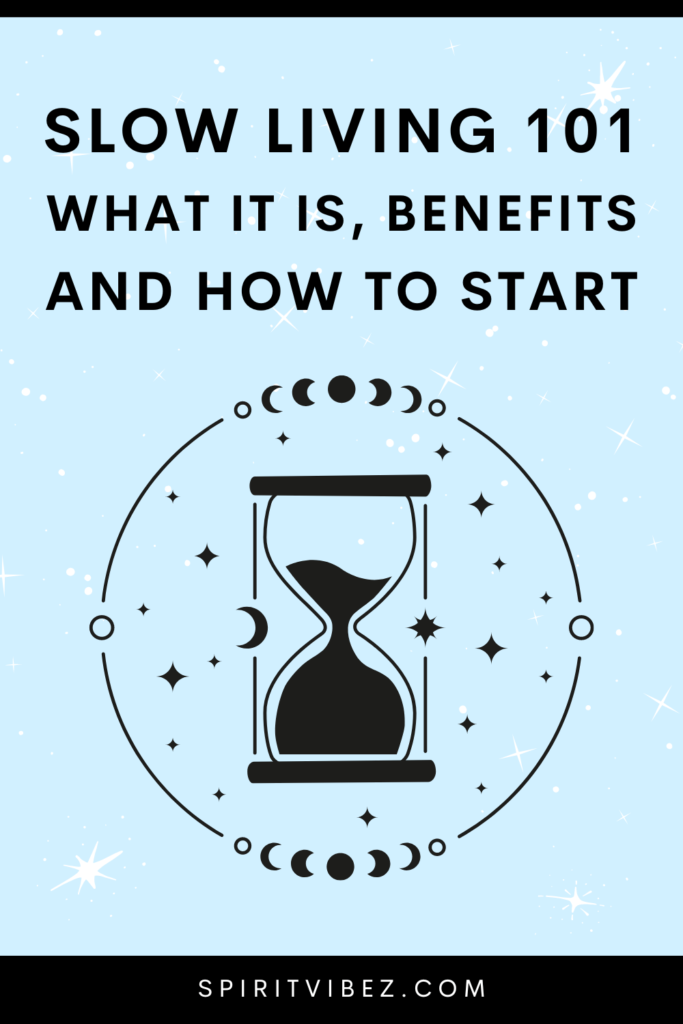Last Updated on July 27, 2023

Imagine a world where busyness takes a backseat, where you have the time to truly savor life’s experiences, and where peace and contentment flourish. This hidden gem, often overlooked, holds the key to a more fulfilling existence.
In today’s article, you’ll learn all about the art of slow living, including what it is, the benefits, and how you can begin practicing a slow living lifestyle.
What is slow living?
A slow living lifestyle is an approach that values a slower pace of life and emphasizes mindfulness, simplicity, and meaningful connections. It’s about prioritizing well-being and taking the time to enjoy life’s simple pleasures, rather than being constantly caught up in the fast-paced demands of modern life.
Slow living encourages people to take a step back, focus on what truly matters, and find joy and peace in the present moment. That can involve practices such as decluttering and simplifying one’s possessions and environment, spending time in nature, and embracing slow-paced activities such as cooking, reading, and gardening.
The goal of slow living is to create a more fulfilling and balanced life, with less stress and more time to enjoy the things that bring happiness and meaning.
See also: How to live a holistic lifestyle
What is the difference between simple living and slow living?
Simple living emphasizes reducing material possessions and embracing a minimalist lifestyle. Slow living focuses on intentionally slowing down, savoring the present moment, and embracing a more mindful and deliberate approach to daily experiences.
While simple living focuses on material possessions, slow living emphasizes the pace and mindset of life. Both philosophies advocate for a shift away from consumerism and distractions to find greater fulfillment.
By embracing elements of both, you can create a lifestyle that is characterized by simplicity, mindfulness, and a greater sense of fulfillment.
What are the benefits of slow living?
Slow living refers to a lifestyle philosophy that emphasizes slowing down the pace of life, being mindful of the present moment, and savoring simple pleasures. While the specific benefits may vary from person to person, here are some commonly recognized advantages of practicing slow living:
1. Reduced stress
Slow living encourages a more relaxed and calm approach to life, helping to reduce stress and anxiety. By focusing on the present and taking time for self-care, you can experience improved mental and emotional well-being.
2. Increased mindfulness
Slow living promotes mindfulness, which involves paying attention to the present moment without judgment. This heightened awareness allows you to fully engage in activities, appreciate your surroundings, and cultivate a deeper sense of gratitude.
3. Enhanced relationships
Slowing down allows for more meaningful connections with others. By prioritizing quality time and being fully present in conversations and interactions, relationships can flourish and deepen. Slow living encourages fostering genuine connections and nurturing a sense of community.
4. Improved health and well-being
Slow living prioritizes self-care which leads to improved physical health and overall wellbeing. That includes better sleep patterns, reduced risk of burnout, healthier eating habits, and increased engagement in activities that promote well-being, such as exercise and meditation.
5. Heightened creativity
Slowing down can provide the mental space necessary for creativity to thrive. When you step away from the constant busyness and distractions, you allow your mind to wander, explore new ideas, and engage in activities that inspire creativity.
6. Enhanced productivity and focus
Contrary to what you might expect, slow living can improve productivity. Adopting a more intentional and focused approach allows you to prioritize tasks, eliminate unnecessary distractions, and accomplish meaningful work without feeling overwhelmed or rushed.
7. Sustainable living
Slow living often aligns with the principles of sustainability. By being mindful of consumption habits, you can reduce waste, make more environmentally friendly choices, and develop a greater appreciation for the natural world.
8. Increased satisfaction and fulfillment
Slowing down and embracing a simpler, more intentional lifestyle can lead to a greater sense of satisfaction and fulfillment. By focusing on what truly matters and letting go of unnecessary distractions, you can find joy in the present moment and gain a deeper sense of purpose.
It’s important to note that slow living is a personal journey, and the benefits can vary based on individual circumstances and preferences. However, many people find that adopting elements of the slow living movement can contribute positively to their overall well-being and quality of life.
How do I start slow living?
Practicing slow living can be a deeply personal journey, tailored to individual preferences and circumstances. However, here are ten slow living examples that will help you cultivate a more intentional and mindful approach to life:
1. Disconnect from technology
Set aside designated times to unplug from screens, social media, and digital distractions. Embrace moments of solitude and allow yourself to be fully present without the constant buzz of notifications.
2. Prioritize self-care
Carve out time for self-care activities that nourish your mind, body, and spirit. This can include practices such as meditation, yoga, reading, taking nature walks, journaling, or engaging in hobbies that bring you joy.
3. Practice mindfulness
Cultivate a heightened awareness of the present moment. Engage in activities mindfully, savoring the sensations, and fully immersing yourself in the experience. Pay attention to the small details that often go unnoticed.
4. Embrace slow meals
Take the time to prepare and savor your meals. Cook with fresh ingredients, mindfully eat without rushing, and appreciate the flavors and textures of each bite. Share meals with loved ones and engage in meaningful conversations.
5. Simplify your schedule
Learn to say no to excessive commitments and prioritize activities that align with your values and bring you true fulfillment. Create space in your calendar for rest, leisure, and spontaneous moments of inspiration.
6. Engage with nature
Spend time in natural surroundings, whether it’s a park, garden, beach, or forest. Observe the beauty of the natural world, breathe in fresh air, and reconnect with the rhythms of nature.
7. Practice gratitude
Cultivate a daily gratitude practice by reflecting on and appreciating the small joys and blessings in your life. This simple act can shift your perspective and bring a sense of contentment and abundance.
8. Slow down daily rituals
Transform everyday routines into mindful rituals. Whether it’s brewing a cup of tea, taking a warm bath, or tending to plants, infuse these moments with intention and presence.
9. Engage in creative pursuits
Set aside time for creative expression. Engage in activities such as painting, writing, playing a musical instrument, or engaging in crafts that allow you to tap into your imagination and foster a sense of flow.
10. Cultivate human connections
Prioritize meaningful connections with loved ones. Schedule quality time together, engage in heartfelt conversations, and create memories that deepen your relationships.
Remember, slow living is a mindset and a practice. It’s about embracing a more deliberate and mindful approach to life, one that allows you to savor each moment, find joy in simplicity, and nurture a deeper connection with yourself and the world around you.
If you enjoyed this post on slow living, I would be very grateful if you shared it on Twitter, Facebook, or Pinterest! Thank you❤️
📌 PIN THIS POST FOR LATER


Hello, my name is Sara and I am the founder of Spiritvibez, I’m here to guide you on your spiritual journey toward healing, growth, and self-discovery. I believe that true transformation occurs when the mind, body, and spirit are aligned and working in harmony. Through Spiritvibez, I hope to inspire and empower you to deepen your spiritual practice, embrace your authentic self, and begin living your best life.
